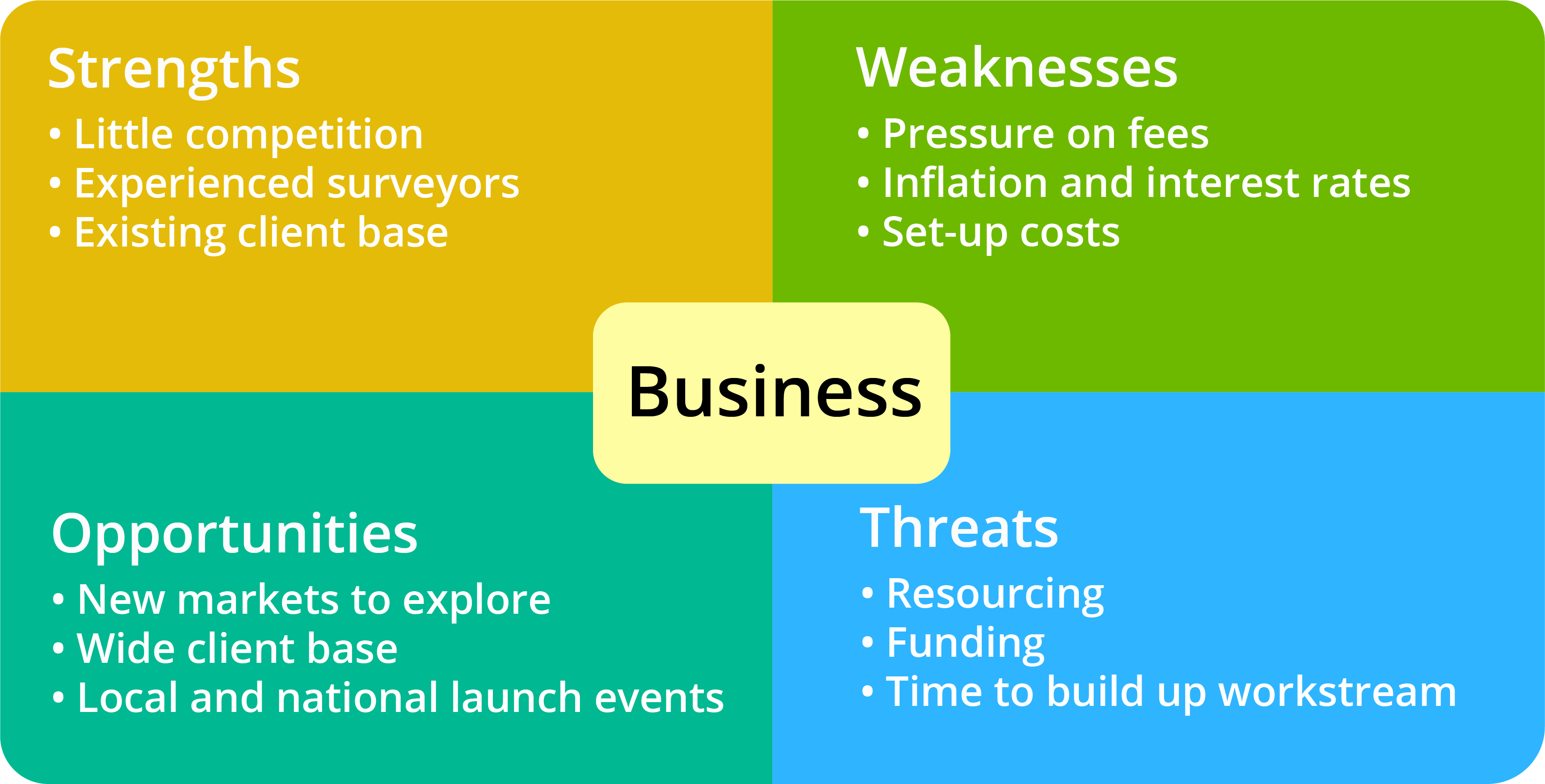
Business planning, a mandatory competency for all APC candidates, requires an understanding of the principles and tools used when devising a business plan, as well as how the process contributes to achieving corporate objectives.
But in addition to this general understanding, you should appreciate the importance of business planning and processes at the firm where you work, as detailed below.
Analysis: analysing a business is a key part of planning for it. This can involve the analysis needed to set up a new business, to manage change in an existing one, or to identify areas for growth or investment. Among the many tools that can be used is a strengths, weaknesses, opportunities and threats (SWOT) analysis. This is a framework that can be applied to any business, helping to identify internal and external factors that affect its performance and to understand current and future potential (see Figure 1).

Figure 1: Example SWOT analysis matrix for a new surveying business
Business types: businesses have a variety of structures, including sole traders, limited companies and partnerships, and understanding the type is important when planning ahead. Being a sole trader is a very simple way to set up a business, but you are then personally liable for its debts. To avoid such liability, you could form a limited company or limited liability partnership (LLP), each of which has its advantages and disadvantages. For example, both are treated very differently for tax purposes, with the former paying corporation tax, and the partners in a latter being taxed individually on their share of the profits. Advice from a tax specialist is always recommended when business planning or considering company structure.
Competition: typically occurring between similar companies serving a similar target market, competition could still come more widely from the same industry or sector. Therefore, analysing who your competitors are and how they are performing can help to inform your business planning, including identifying areas for growth or expansion, or where competition may otherwise be eroding profitability or opportunities.
Debtors and creditors: another part of business planning is understanding who owes money to a business – its debtors – or to whom the business itself owes money – its creditors. For example, a business may have taken a loan, in which case the lender is its creditor; alternatively, it may be owed payment of an invoice by a customer, who would be its debtor. Maintaining good payment practices and being aware of when sums become due is essential for business planning to maintain a good relationship with creditors. Likewise, understanding the amount that debtors owe and recognising any red flags that they are not able to pay can help avoid cash-flow issues and keep the business running smoothly.
Elements: a business plan will typically include some or all of the following elements:
- an executive summary
- a business description
- a market analysis and strategy
- a marketing and sales plan
- an analysis of the competition, including their services
- an operating plan
- detail of company structure
- financial analysis
- objectives or goals
- summary of the strategy.
There is no fixed format or structure to a business plan, however, as this will be tailored to the specific business in question. You should still have read and be familiar with your firm's business plan.
Forecasting: this is an essential part of business planning, allowing consideration of what may happen in the future. However, as business planning can be akin to gazing into a crystal ball, it is often impossible to predict accurately. Using a variety of business planning tools and accurate, up-to-date data will help you make forecasting as useful as possible. You may for instance use work-in-progress schedules or forecast planned billing for instructions on which you are currently working.
Goals: these are what a business wants to achieve in the short, medium and long term, and could include improving service quality or profitability, or simply completing a project on time. Goals are most effective when they are specific, measurable, achievable, relevant and time-bound (SMART). For example, a goal of delivering reports within seven days of instruction is SMART whereas one that requires reports 'as quickly as possible' is not; the former is measurable and will be far more effective than the latter when considering whether the business has achieved its goals or not.
Horizons: businesses should plan to short-, medium- and long-term horizons, as their goals will apply not only to tomorrow but to longer periods as well – for instance, five to ten years. Planning over these different time horizons will help to keep a business on track and ensure that it is not just focusing on short-term gain – which often results in long-term pain.
Investment: at some stage in its journey, a business will need investment to grow. This could be financial, in the form of a loan or equity finance from a creditor, or it could be investment in training, service development or resourcing, such as hiring more staff or buying better equipment. Planning will identify the investment needs of a business and help develop a strategy to fund and resource these appropriately over the correct time horizon.
Joint ownership: most businesses will be jointly owned, with directors, shareholders or partners – depending on the business type – having a variety of views and goals. Being able to balance the needs of these joint owners will be key to success: a business that is being pulled in more than one direction or facing volatile management and leadership is unlikely to be successful. Having a clearly written plan that aligns the owners' interests to the goals and strategy of the business is therefore essential.
Key performance indicators (KPIs): these are quantifiable measures of performance over time for a specific objective, such as delivering reports within seven days or achieving a certain level of sales per department. Measuring KPIs consistently helps a business to track progress and identify trends, or to put plans in place where the indicators are not met. They can also keep a business focused on the right goals and avoid it becoming side-tracked. KPIs are typically monitored in a monthly report using a bespoke spreadsheet or database, shared with key staff.
'As business planning can be akin to gazing into a crystal ball, it is often impossible to predict accurately. Using a variety of business planning tools and accurate, up-to-date data will help you make forecasting as useful as possible'
Liquidity: this is a measure of how quickly a business can convert assets into cash, thus being able to meet short-term financial obligations. Lacking liquidity can be a problem when payments such as VAT or tax are due. However, holding too much money in liquid sources such as cash can limit a business's capital growth. In contrast, investing in property can make funds particularly illiquid – although this might be a good strategy for capital growth and supporting business strategy.
Market research: this is essential for a business, whether it is at the start-up stage or more mature, to understand the market in which it operates and its trends, as well as potential threats and opportunities. Market research is not just something to do once; it is a continuous process because markets are dynamic, and changes to interest rates, tax or competitors, for example, may dramatically affect business strategy. Any research completed should be summarised in the business plan, and the source documents kept on file for future reference.
Net profit: there is a popular saying that turnover is vanity, profit is sanity and cash is reality. Business health is important to consider when planning ahead and a key measure of this is net profit, also known as the bottom line. This is calculated by deducting operating, interest and tax expenses from growth profit. Net profit gives a good indication of business health and available funds, whereas turnover can mask the actual cost of operations: knowing both figures is essential to robust business planning.
Objectives: when planning, it is essential to align a business's goals with its wider corporate objectives. These are usually developed from the mission statement and set by those at the top of an organisation. Departmental-level objectives can be developed from the main corporate ones, and this helps to align the organisation's work. If a business strategy does not support these objectives, you could question whether it is the right strategy for the business.
Political, economic, sociological, technological, legal and environmental (PESTLE): this is another form of business analysis, based on the six named external factors. A business can consider these to assess the context in which it is operating for planning purposes. For example, what wider economic factors are affecting business performance? What technological innovations might help make the business more effective? And what environmental concerns does the business need to consider?
'Planning will identify the investment needs of a business and help develop a strategy to fund and resource these appropriately over the correct time horizon'
Quantitative and qualitative: business analysis tools can be both quantitative and qualitative. The former are based on facts and figures, whereas the latter use non-numerical data such as opinions or statements. Combining these forms of data can inform more robust business planning: for example, measuring performance data from a variety of sources and then discussing this with the staff or management involved to better understand their thinking.
Ratios: measuring financial ratios, such as working capital, debt and equity, profit margin and current ratio, can help to analyse a business's performance and inform planning. Using these ratios helps when trying to understand how efficient a business is, either by comparing past and present performance or its own performance with the ratios of competitors. These ratios could be included in the financial analysis section of a business plan.
Structure: understanding the structure of an organisation is key to successful business planning. There are various possible business structures, such as vertical, vertical and horizontal – or matrix – and open-boundary. A vertical structure could be functional, with a president at the top and roles such as head of HR and head of finance immediately beneath them. A vertical structure could also be divisional, with divisions beneath the president then split under various heads. Matrix structures have dual command, with employees reporting to two managers: say, one who is head of HR and another who is head of a division. Finally, open-boundary structures are varied and flexible, with connections where they are most effective between teams. There are many other types of organisational structure, though, and you should be sure you are able to explain how your firm operates.
Types of business plan: these include corporate, or top-level; departmental, at a lower level; strategic, with a specific function or service and a longer-term horizon; and operational, concerning how things work on a day-to-day basis. A business may therefore have more than one business plan: it is likely to have an overall corporate plan and then separate lower-level plans for departments, teams or specific services. The lower-level plans should align to the wider corporate business plan, however.
Unique selling point (USP): a USP helps define a business and the way it differentiates itself in the market. This should be included in the business plan, marketing campaigns and in the values set out by the business. Some firms may focus on a high-priced, high-quality product, while others may focus on low-cost, volume services, for example.
Variability: a business's fortunes and prospects will vary from year to year and with business cycles. It is vital, therefore, to monitor and update the business plan on an ongoing basis to help a business remain stable and avoid too variable a performance. All businesses will not only experience but also require change. However, if this can be planned and managed well, a business can remain profitable and efficient.
Working capital: this represents the funds available for a business to meet its current, short-term obligations. The amount of working capital required is calculated by dividing current assets by current liabilities, with the ideal ratio being between 1.5 and 2. This would suggest that a business is healthy and can meet its obligations in the short term.
X-ray: taking an X-ray approach means exploring all data about a business, speaking with relevant personnel and leaving no stone unturned. This will help to ensure that business plans are relevant and offer the best chance of success. While no one can predict the future, having good data available will still help you to manage change when required.
Year-end: knowing when a company's financial year ends can help when business planning, including managing tax payments and staff bonuses. Its year-end may differ to the end of the tax year, which falls on 5 April. Business plans may run on the company year-end, the tax year-end or on calendar years, depending on when a business was registered. Tax advice should be sought on whether staggering year ends may be beneficial, but this will depend on the specific circumstances.
Zenith: the Oxford English Dictionary defines this as 'the time or period at which something is at its best, most successful [or] most powerful'. A plan will help a business to project itself towards its zenith, and aiming realistically high will give it the best chance of reaching this point.
As an example of the aspects of business planning discussed in this article, all candidates should read and be familiar with the current RICS Business Plan. This includes the organisation's corporate objectives, market plans, risks and strategy for the years ahead.
'All businesses will not only experience but also require change. However, if this can be planned and managed well, a business can remain profitable and efficient'
Jen Lemen FRICS is co-founder of Property Elite
Contact Jen: Email
Related competencies include: Business planning

